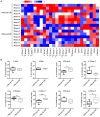Age-Related Changes in the Gut Microbiota Modify Brain Lipid Composition
- PMID: 31993375
- PMCID: PMC6970973
- DOI: 10.3389/fcimb.2019.00444
Age-Related Changes in the Gut Microbiota Modify Brain Lipid Composition
Abstract
Understanding the molecular mechanisms underlying the changes observed during aging is a prerequisite to design strategies to prevent age-related diseases. Aging is associated with metabolic changes, including alteration in the brain lipid metabolism. These alterations may contribute to the development of pathophysiological conditions. Modifications in the gut microbiota composition are also observed during aging. As communication axes exist between the gut microbiota and the brain and knowing that microbiota influences the host metabolism, we speculated on whether age-associated modifications in the gut microbiota could be involved in the lipid changes observed in aging brain. For that purpose, germ-free mice were colonized by the fecal microbiota of young or old donor mice. Lipid classes and fatty acid profiles were determined in the brain (cortex), plasma and liver by thin-layer chromatography on silica gel-coated quartz rods and gas chromatography. Gut colonization by microbiota of old mice resulted in a significant increase in total monounsaturated fatty acids (MUFA) and a significant decrease in the relative amounts of cholesterol and total polyunsaturated fatty acids (PUFA) in the cortex. Among the eight most represented fatty acids in the cortex, the relative abundances of five (C18:1n-9, C22:6n-3, C20:4n-6, C18:1n-7, and C20:1n-9) were significantly altered in mice inoculated with an aged microbiota. Liquid chromatography analyses revealed that the relative abundance of major species among phosphatidyl and plasmenylcholine (PC 16:0/18:1), phosphatidyl and plasmenylethanolamine (PE 18:0/22:6), lysophosphatidylethanolamine (LPE 22:6) and sphingomyelins (SM d18:1/18:0) were significantly altered in the cortex of mice colonized by the microbiota obtained from aged donors. Transplantation of microbiota from old mice also modified the lipid class and fatty acid content in the liver. Finally, we found that the expression of several genes involved in MUFA and PUFA synthesis (Scd1, Fads1, Fads2, Elovl2, and Elovl5) was dysregulated in mice inoculated with an aged microbiota. In conclusion, our data suggest that changes in gut microbiota that are associated with aging can impact brain and liver lipid metabolisms. Lipid changes induced by an aged microbiota recapitulate some features of aging, thus pointing out the potential role of microbiota alterations in the age-related degradation of the health status.
Keywords: aging; cholesterol; cortex; fatty acid; lipid; liver; microbiota; phospholipid.
Copyright © 2020 Albouery, Buteau, Grégoire, Cherbuy, Pais de Barros, Martine, Chain, Cabaret, Berdeaux, Bron, Acar, Langella and Bringer.
Figures







Similar articles
-
The gut microbiota promotes hepatic fatty acid desaturation and elongation in mice.Nat Commun. 2018 Sep 14;9(1):3760. doi: 10.1038/s41467-018-05767-4. Nat Commun. 2018. PMID: 30218046 Free PMC article.
-
Soluble Fiber Inulin Consumption Limits Alterations of the Gut Microbiota and Hepatic Fatty Acid Metabolism Caused by High-Fat Diet.Nutrients. 2021 Mar 23;13(3):1037. doi: 10.3390/nu13031037. Nutrients. 2021. PMID: 33806985 Free PMC article.
-
Association Between Genetic Variants in FADS1-FADS2 and ELOVL2 and Obesity, Lipid Traits, and Fatty Acids in Tunisian Population.Clin Appl Thromb Hemost. 2020 Jan-Dec;26:1076029620915286. doi: 10.1177/1076029620915286. Clin Appl Thromb Hemost. 2020. PMID: 32584610 Free PMC article.
-
Dietary lipids, gut microbiota and lipid metabolism.Rev Endocr Metab Disord. 2019 Dec;20(4):461-472. doi: 10.1007/s11154-019-09512-0. Rev Endocr Metab Disord. 2019. PMID: 31707624 Free PMC article. Review.
-
Fatty acids and beyond: Age and Alzheimer's disease related changes in lipids reveal the neuro-nutraceutical potential of lipids in cognition.Neurochem Int. 2021 Oct;149:105143. doi: 10.1016/j.neuint.2021.105143. Epub 2021 Jul 23. Neurochem Int. 2021. PMID: 34311029 Review.
Cited by
-
Gut microbiota is involved in male reproductive function: a review.Front Microbiol. 2024 May 3;15:1371667. doi: 10.3389/fmicb.2024.1371667. eCollection 2024. Front Microbiol. 2024. PMID: 38765683 Free PMC article. Review.
-
The microbiome is associated with obesity-related metabolome signature in the process of aging.NPJ Biofilms Microbiomes. 2025 Aug 25;11(1):173. doi: 10.1038/s41522-025-00811-w. NPJ Biofilms Microbiomes. 2025. PMID: 40851038 Free PMC article.
-
Nootropic foods in neurodegenerative diseases: mechanisms, challenges, and future.Transl Neurodegener. 2025 Apr 3;14(1):17. doi: 10.1186/s40035-025-00476-7. Transl Neurodegener. 2025. PMID: 40176115 Free PMC article. Review.
-
A comprehensive analysis of intratumor microbiome in head and neck squamous cell carcinoma.Eur Arch Otorhinolaryngol. 2022 Aug;279(8):4127-4136. doi: 10.1007/s00405-022-07284-z. Epub 2022 Feb 5. Eur Arch Otorhinolaryngol. 2022. PMID: 35122129
-
Gut microbiota and microbial metabolites for osteoporosis.Gut Microbes. 2025 Dec;17(1):2437247. doi: 10.1080/19490976.2024.2437247. Epub 2024 Dec 17. Gut Microbes. 2025. PMID: 39690861 Free PMC article. Review.
References
Publication types
MeSH terms
Substances
LinkOut - more resources
Full Text Sources
Medical
Research Materials

